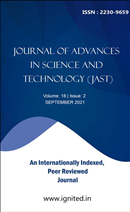A Study of Nanocomposite for Photocatalytic Degradation of Organic Contaminants under visible light
Keywords:
Nanocomposite, Photocatalytic, Visible-Light, CatalysisAbstract
The escalating concerns regarding environmental pollution have spurred significant interest in developing efficient photocatalytic materials for the degradation of organic contaminants. This study investigates nanocomposites for visible-light photocatalytic destruction of organic pollutants, considering the limitations of UV-only photocatalysts. Given that a significant fraction of the solar spectrum is visible light, the capacity to utilize this light for catalytic reactions is critically important. The nanocomposite consists of a semiconductor material doped with noble metal nanoparticles, designed to enhance light absorption and charge separation efficiency. Through a series of synthesis techniques and characterization methods including X-ray diffraction, scanning electron microscopy, and UV-Vis spectroscopy, the structural and optical properties of the nanocomposite are thoroughly investigated.
Downloads
References
A. Isari, A. Payan, M. Fattahi, S. Jorfi, B. Kakavandi, Photocatalytic degradation of Rhodamine B and Real Textile Wastewater using Fe-Doped TiO2 anchored on Reduced Graphene Oxide (Fe-TiO2 /rGO): Characterization and feasibility, mechanism and pathway studies, Applied Surface Science 462, (2018) 549-564.
Aazam, E. S. (2014). Visible light photocatalytic degradation of thiophene using Ag–TiO2/multi-walled carbon nanotubes nanocomposite. Ceramics International, 40(5), 6705-6711.
Anjum, M., Kumar, R., & Barakat, M. A. (2017). Visible light driven photocatalytic degradation of organic pollutants in wastewater and real sludge using ZnO–ZnS/Ag2O–Ag2S nanocomposite. Journal of the Taiwan Institute of Chemical Engineers, 77, 227-235.
Anwer, H., & Park, J. W. (2018). Synthesis and characterization of a heterojunction rGO/ZrO2/Ag3PO4 nanocomposite for degradation of organic contaminants. Journal of hazardous materials, 358, 416-426.
Behzadifard, Z., Shariatinia, Z., & Jourshabani, M. (2018). Novel visible light driven CuO/SmFeO3 nanocomposite photocatalysts with enhanced photocatalytic activities for degradation of organic pollutants. Journal of Molecular Liquids, 262, 533-548.
C. H. Yanga, L.S, Wang, S.Y. Chena, M.C. Huanga, Y.H. Lia, Y.C, Lina, P.F. Chena, J.F. Shawa, and K.S. Huang, “Microfluidic assisted synthesis of silver nanoparticle–chitosan composite microparticles for P. H. C. Camargo, K.G. Satyanarayana, and F. Wypych, “Nanocomposites: Synthesis, Structure, Properties, and New Application Opportunities,vol. 12(1), pp1-39, September 2009.
Heegde MS, ?Nagaveni K, Sivalingam 2004, ‘ Solar photocatalytic degradation of dyes: Hiugh activity of combustion synthesized nano TiO2’ Applied catalysis B: Environmerntal, vol. 48, no.2, pp-83-93.
R.A.M. Said, M. A. Hassan, A.M. Abdelzaher, and A. M. A. Raoof, “Review—Insights into the Developments of Nanocomposites for Its Processing and Application as Sensing Materials, ” Journal of The Electrochemical Society, vol. 167 (3), pp1-9, January 2020
S. Sivasankaran, “Composite Materials, Nanocomposites, Recent Evolutions”, 2019, DOI: 10.5772/ intechopen.73364, ISBN:978-1-78985-012-3, Intech Open Publications.
Vijayalakshi, R & Rajendran V 2012, ‘ Synthesis and characterization of nano TiO2 via different methods’ , Archives of Applied science Research, vol.4, no.2, pp. 1183-1190.
Yuan, X., Floresyona, D., Aubert, P. H., Bui, T. T., Remita, S., Ghosh, S., ... & Remita, H. (2019). Photocatalytic degradation of organic pollutant with polypyrrole nanostructures under UV and visible light. Applied Catalysis B: Environmental, 242, 284-292.






